Set Up and Launch a Profitable Facebook Ads Campaign in 8 Steps
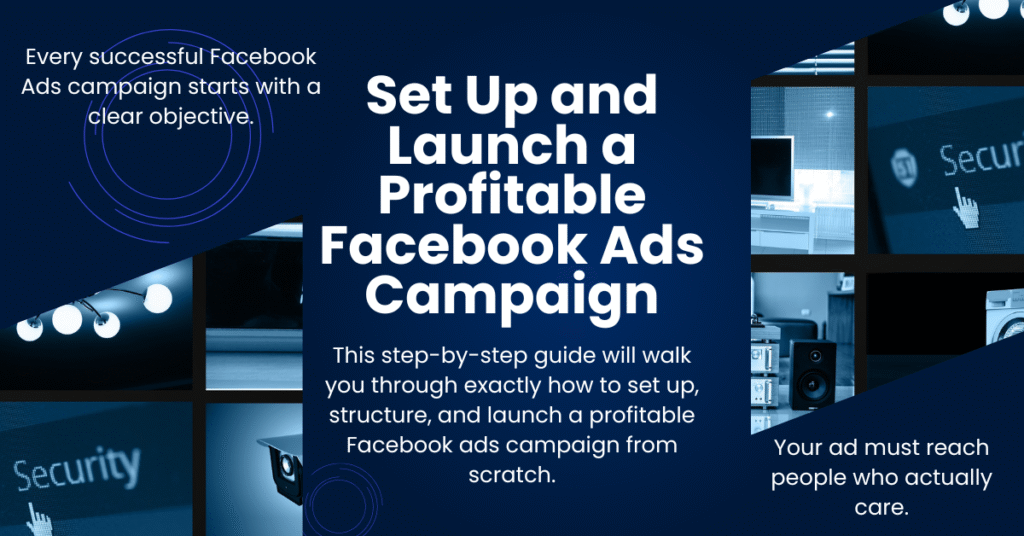
Introduction Running Facebook ads is easy. Running Facebook ads that actually convert into paying customers? That’s where most businesses struggle. In fact, according to WordStream, the average conversion rate for Facebook ads across industries is only 9.21%, meaning most advertisers lose money on poorly planned campaigns. But here’s the truth: when done right, Facebook ads can be the most profitable customer acquisition channel available today. Whether you’re a small business owner, an eCommerce store, a coach, or a freelancer, you can use Facebook ads to consistently attract leads and sales without wasting your budget. This step-by-step guide will walk you through exactly how to set up, structure, and launch a profitable Facebook ads campaign from scratch. And throughout, I’ll share insights from Adeleke Samuel’s Ultimate Facebook Ads Blueprint, a trusted system that has helped thousands of Nigerian and international businesses scale online. Let’s dive in. Prerequisites: Set Up Your Infrastructure Before you touch “Create” in Ads Manager, make sure your foundation is ready. Create & connect: Meta Business Manager (own your assets; don’t run from personal). Ad Account + Facebook Page + Instagram account. Pixel (Web) and Conversions API (CAPI) connection. Domain verification (for event prioritization). Commerce Manager / Product Catalog (e-commerce) or Lead form/CRM (lead-gen). Payment methods (consider local options: Paystack/Flutterwave in Nigeria). Legal & compliance: privacy policy, terms, cookie banner if needed. QA checklist (copy/paste): Create & connect: Meta Business Manager (own your assets; don’t run from personal). Ad Account + Facebook Page + Instagram account. Pixel (Web) and Conversions API (CAPI) connection. Domain verification (for event prioritization). Commerce Manager / Product Catalog (e-commerce) or Lead form/CRM (lead-gen). Payment methods (consider local options: Paystack/Flutterwave in Nigeria). Legal & compliance: privacy policy, terms, cookie banner if needed. QA checklist (copy/paste): Business Manager verified Page and IG linked to Ad Account Pixel firing PageView & test events Domain verified; events prioritized CAPI connected (dedup IDs matched) Catalog synced (if e-com) CRM capture tested (if lead-gen Step 1: Define Your Campaign Objective (Know Your “Why”) Every successful Facebook Ads campaign starts with a clear objective. In Facebook Ads Manager, you’ll see three broad categories: Awareness (brand awareness, reach) Consideration (traffic, engagement, video views, lead generation, messages) Conversion (sales, store visits, catalog sales) 💡 Think of this like a football match: your objective is the goalpost. If you don’t define it, your players (ads) will just keep running around the field with no aim. 👉 Example: If you’re a bakery in Lagos, running an “Awareness” campaign might get 20,000 people to see your cakes, but no orders. But if your goal is “Conversions” with a checkout system linked, you can directly track sales made from your ad clicks. ✅ Action Step: Before creating your ad, write down your #1 campaign goal in one sentence: “I want to generate 200 qualified leads in 30 days.” 📘 Pro Tip: Adeleke Samuel’s Blueprint goes deeper by showing you which campaign objective fits best for different business models, eCommerce, coaching, restaurants, real estate, etc. This saves you from wasting money choosing the wrong goal. Step 2: Know Your Audience (Targeting Like a Pro) You can’t sell ice to Eskimos or rather, you can, but it’s a waste of money. Your ad must reach people who actually care. Facebook gives you three targeting levels: Core Audiences – defined by age, gender, location, interests. Custom Audiences – retargeting people who visited your site, used your app, or engaged with your content. Lookalike Audiences – finding new people similar to your best customers. 👉 Case Study: One of Adeleke’s Nigerian clients a fashion store ran ads targeting “women 18-45 in Lagos.” They got traffic but poor sales. After using Custom + Lookalike audiences (based on previous buyers), sales doubled within 14 days without increasing ad spend. ✅ Action Step: Start small with specific targeting (e.g., “Women 25–40, Lagos, Interests: Ankara fashion, online shopping”). Gradually test Custom and Lookalike audiences as your pixel collects data. 📘 Pro Tip: Adeleke’s Blueprint teaches advanced audience layering, how to combine behaviors, demographics, and interests so your ads only reach the highest-quality leads. Step 3: Create Irresistible Ad Copy (Speak to Pain Points) Ad copy is the heart of persuasion. People don’t care about your product; they care about their problem. Your ad should show you understand their pain, then offer a solution. Formula for powerful ad copy: Hook – Grab attention (pain point or bold statement). Story – Relate with empathy. Solution – Show how your offer fixes their problem. CTA – Tell them exactly what to do next. 👉 Example:Instead of:“Buy our cake today! Fresh and sweet.” Say:“Tired of boring birthdays? 🎂 Surprise your loved one with a custom cake that makes their day unforgettable. Order now and get same-day delivery in Lagos.” ✅ Action Step: Write 3 variations of your ad copy. Test which one resonates most. 📘 Pro Tip: Adeleke’s Blueprint includes proven ad copy templates for different industries so you don’t stare at a blank screen wondering what to write. Step 4: Design Scroll-Stopping Creatives Facebook is a visual platform. Your ad creative (image, video, carousel) is what makes people stop scrolling. Images should be bright, clear, and emotion-driven. Videos perform best short, authentic, and storytelling-focused. Carousels work well for showing multiple products. 👉 Case Study: A Lagos fitness coach used stock photos for her ads and saw little traction. After switching to short iPhone-shot videos of herself demonstrating workouts, engagement tripled and leads doubled. ✅ Action Step: Use Canva for professional images. Keep videos under 60 seconds, with captions. Test at least 2–3 creatives per ad set. 📘 Pro Tip: Adeleke’s Blueprint shows how to design ad creatives even if you’re not a designer, plus tools to hack high-performing visuals. Step 5: Build a High-Converting Landing Page Your ad can be perfect, but if your landing page is weak, people won’t buy. A great landing page has: Clear headline (what problem you solve). Compelling benefits (not features). Social proof (testimonials, reviews). One single CTA (buy, book, download).
5 Powerful Reasons Your Facebook Ads Get Clicks But No Sales (And How to Fix Them)
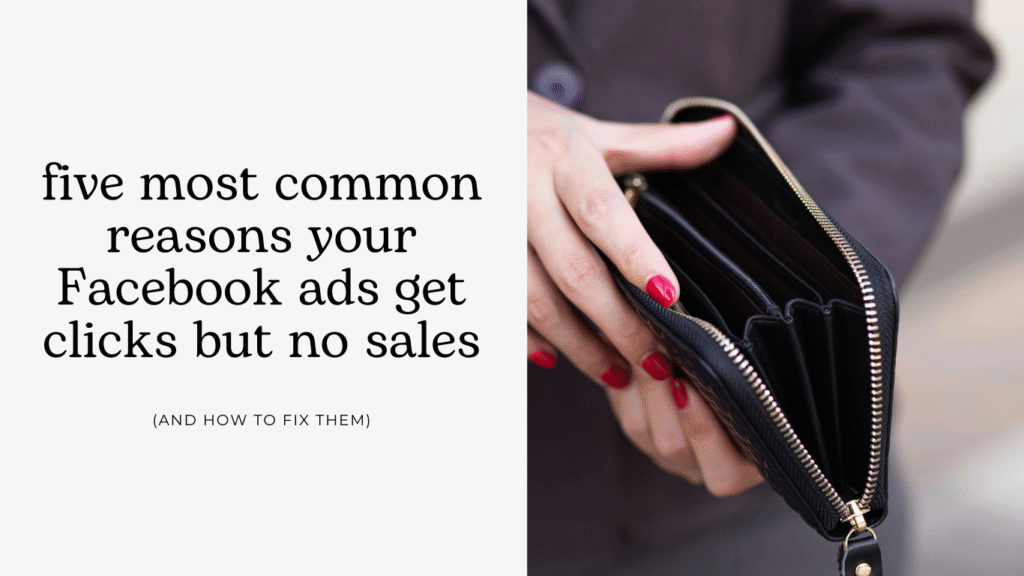
Introduction You launch a Facebook ad campaign with high hopes. The targeting looks right, the creative is polished, and soon enough, the clicks start rolling in. Your ad manager dashboard shows promising numbers: thousands reached, hundreds of clicks, and an impressive click-through rate (CTR). But when you check your sales dashboard… nothing. Not a single conversion. This situation is more common than you think. In fact, studies show that the average Facebook ad conversion rate across industries is just 9.21%, which means the majority of clicks don’t turn into sales. For small businesses with limited budgets, this gap between clicks and sales is not just frustrating, it’s financially draining. So, why does this happen? Why do people engage with your ad but fail to take the final step of purchasing? Let’s break down the five most common reasons your Facebook ads get clicks but no sales and more importantly, how to fix each one. 1. Wrong Audience Targeting Your ad might be eye-catching enough to make people click, but if those people don’t actually need or want what you’re offering, they’ll never buy. This is the classic “wrong people, wrong place, wrong time” problem. Imagine running an ad for a $500 photography course but targeting everyone interested in “photography.” Your clicks may come from: Teenagers who love snapping pictures for fun. People looking for free tutorials on YouTube. Hobbyists with no intention of spending money. These clicks cost you money but bring no return. Case Study Example A fashion brand once targeted “all women aged 18–45 interested in fashion.” Their ads generated thousands of clicks but almost no purchases. Why? Because the majority of that audience couldn’t afford premium-priced clothes. When they switched to targeting women who followed luxury fashion brands (like Gucci, Prada, Dior), their conversions improved drastically. How to Fix It Leverage Lookalike Audiences: Upload your customer list and let Facebook find similar people. This ensures your ads reach those most likely to buy. Use Layered Targeting: Combine demographics (age, income, location) with specific interests. Example: “Entrepreneurs + Interested in Facebook Ads + Has made online purchases.” Exclude Unqualified Audiences: Exclude students, freebie seekers, or irrelevant groups. Retarget Warm Audiences: Run ads to website visitors, email subscribers, or past customers, warm traffic almost always converts better than cold. 👉 Remember: Clicks from the wrong audience are vanity metrics. You need buyers, not browsers. 2. Weak or Unclear Offer Even if your audience is perfect, they won’t buy if your offer doesn’t feel valuable or urgent. A weak offer usually: Doesn’t solve a pressing problem. Looks generic (same as everyone else’s). Isn’t positioned as a must-have. For example: Weak offer → “Buy my eBook on Facebook ads.” Strong offer → “Learn how to create Facebook ads that generate leads in 7 days even if you’ve never run an ad before. Includes templates and ad copy formulas.” The second version paints a picture of transformation. Example of Value vs Weak Offer Imagine you’re promoting a weight-loss program. Weak: “Join our weight-loss program today.” Strong: “Lose up to 10 pounds in 30 days with our personalized coaching guaranteed.” The second offer directly addresses pain points (weight loss, timeline, guarantee). How to Fix It Add Bonuses: Templates, checklists, free consultations. Show ROI (Return on Investment): If your product saves time, show “Save 10 hours a week.” If it makes money, show “Earn $500/month in passive income.” Build Scarcity: Limited spots, early-bird discounts, countdown timers. Focus on Transformation: Sell the outcome, not just the product. 👉 Clicks don’t convert into sales if the offer feels average. Make your offer irresistible. 3. Poor Landing Page Experience Your ad can be perfect, but if your landing page is slow, messy, or irrelevant, you’ll lose customers instantly. In fact, a 1-second delay in page load time can reduce conversions by 7% (Akamai study). Typical landing page mistakes include: Sending traffic to a homepage instead of a focused landing page. Overloading with text, popups, or confusing navigation. Not being mobile-friendly (over 90% of Facebook users access via mobile). Example Scenario An online store ran ads promoting “50% off on sneakers” but sent traffic to the homepage, where customers had to search manually for the deal. Bounce rate skyrocketed. Once they created a landing page showcasing only the discounted sneakers with a “Shop Now” button, sales improved by 230%. How to Fix It Dedicated Landing Pages: Each ad campaign should lead to a matching landing page. One Clear CTA: Remove clutter. If your goal is a sale, don’t include 5 different buttons. Optimize for Mobile: Responsive design, readable fonts, and fast load times. Use Visual Proof: Before/after photos, product demos, videos. 👉 Your landing page is the bridge between a click and a sale. If the bridge is weak, customers won’t cross. At digital marketing agency, you can get your fully seo optimised landing page. contact us to book a session 4. Misaligned Ad Message When your ad says one thing but your landing page delivers something else, people feel misled and leave. This “expectation mismatch” kills conversions. Example: Ad promises: “Free Guide to Growing Your Instagram.” Landing page asks: “Pay $29 for this Instagram course.” The result? Users feel tricked, and trust is broken. Case Example A SaaS company promoted a “Free Trial” in their ad. But the landing page only had a “Book a Demo” option. Conversion rates dropped to 0.4%. When they aligned the landing page to match the free trial promise, conversion rates jumped to 6.3%. How to Fix It Match Headlines: Your ad and landing page should use the same promise/wording. Use Consistent Design: Colors, images, and fonts should be similar. Fulfill the Promise: If the ad says “Download Free Guide,” the landing page headline should say the same. 👉 Think of your ad as the invitation and your landing page as the event. If the event doesn’t match the invitation, people walk away. 5. Lack of Trust & Social Proof Even if everything else is right, people won’t buy if they
7 Powerful Reasons Why Digital Marketing Outshines Content Marketing
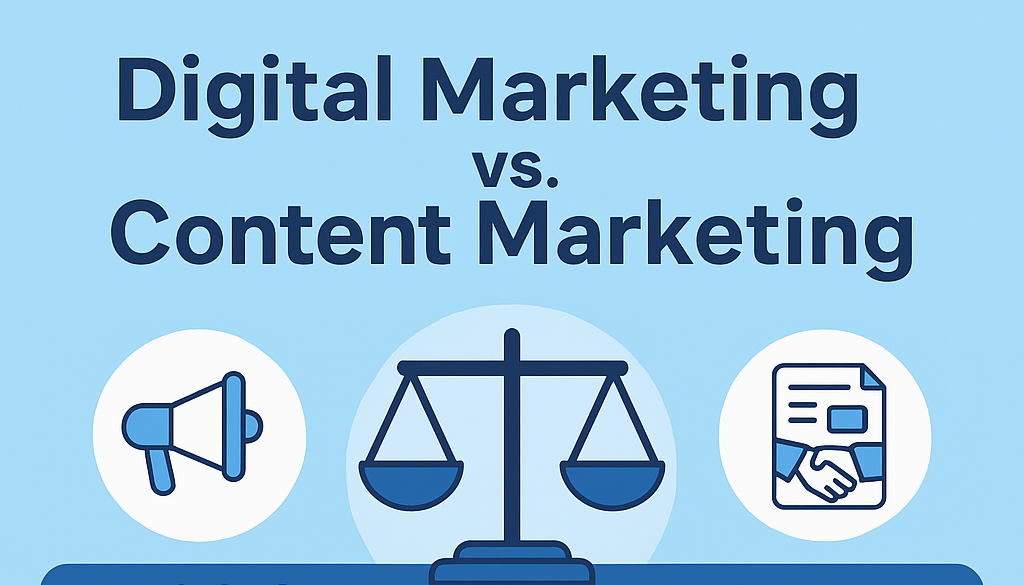
Digital marketing and content marketing are complementary yet distinct disciplines. Digital marketing encompasses all online promotional activities—SEO, PPC, social media, email—designed to drive traffic, leads, and sales across digital channels. Conversely, content marketing is a strategic subset focused on creating and distributing valuable, relevant content to attract and retain a clearly defined audience, ultimately driving profitable customer action. While digital marketing casts a wide net using paid and organic tactics, content marketing builds long-term authority and trust through consistent storytelling and educational assets. Together, they form a powerful synergy: content fuels digital campaigns, and digital channels amplify content reach for sustainable growth. Table of Contents Defining Digital Marketing Defining Content Marketing Core Objectives: Traffic vs. Trust Key Channels and Tactics Digital Marketing Channels Content Marketing Channels Measurement and KPIs Budget and Resource Allocation Integrating Digital and Content Marketing Case Studies & Examples Common Pitfalls to Avoid Building a Combined Strategy Conclusion Digital Marketing Digital marketing refers to any marketing activities conducted through digital channels—websites, search engines, social media, email, mobile apps, and more—to connect with current and prospective customers. It includes both organic tactics (SEO, social media engagement) and paid tactics (PPC, display ads, sponsored posts) to drive immediate traffic and conversion. With the global digital advertising market projected to reach $786 billion by 2026, digital marketing remains the backbone of modern promotional efforts. Why It Matters Scalability & Speed: Paid ads and programmatic channels can generate traffic instantly. Targeting Precision: Advanced targeting—by demographics, behavior, intent—ensures the right message reaches the right audience. Data-Driven Optimization: Real-time analytics allow for iterative campaign improvements. Content Marketing Content marketing is a long-term strategic approach focused on creating and distributing valuable, relevant, and consistent content to attract and retain a clearly defined audience—and ultimately, to drive profitable customer action. Unlike one-off advertising, content marketing builds authority and trust over time by educating and engaging prospects through formats like blog posts, eBooks, videos, podcasts, and infographics. Why It Matters Trust & Credibility: High-quality content positions your brand as an expert. SEO Benefits: Regular, optimized content boosts organic search rankings and visibility. Evergreen Value: Well-crafted pieces continue to attract traffic and leads long after publication. Core Objectives: Traffic vs. Trust Focus Digital Marketing Content Marketing Primary Goal Drive traffic & conversions immediately Build long-term authority & audience loyalty Approach Broad reach via paid & organic channels Value-driven storytelling & education Timeframe Short-term campaigns Long-term relationship building ROI Model Measurable cost-per-lead/sale Cumulative ROI through sustained engagement Digital marketing excels at quick wins, especially for promotional offers and time-sensitive campaigns. Content marketing shines in earned awareness, nurturing leads through the buyer’s journey with educational assets. Key Channels and Tactics Digital Marketing Channels Search Engine Marketing (SEM/PPC): Paid ads on search engines for immediate visibility. Social Media Advertising: Sponsored posts on Facebook, LinkedIn, Instagram, TikTok. Display & Programmatic Ads: Banner, video, and native ads across the web. Email Marketing: Targeted campaigns for promotions, drip sequences. Affiliate & Influencer Marketing: Partner-driven referrals and endorsements. These channels offer precision targeting and action-oriented calls to action (CTAs), making them ideal for driving conversions and measurable ROI. Content Marketing Channels Blogs & Articles: Foundation for SEO and thought leadership. Ebooks & Whitepapers: Deep dives used as lead magnets. Infographics & Visual Assets: Quickly convey complex data. Videos & Webinars: High engagement and shareability. Podcasts & Interactive Tools: Build community and recurring touchpoints citeturn0search5. Content channels focus on value delivery, education, and brand storytelling—fueling organic traffic and social shares. Measurement and KPIs Metric Digital Marketing Content Marketing Traffic Impressions, Clicks Page Views, Time on Page Engagement CTR, Conversion Rate Social Shares, Comments, Backlinks Cost Metrics CPA, CPC, CPM Content Production Cost vs. Leads Long-Term Impact Revenue per Campaign Lead Velocity, Brand Lift Digital marketing KPIs are often short-term and budget-driven. Content marketing KPIs emphasize evergreen value and cumulative lead generation. Budget and Resource Allocation Digital Marketing: Paid ad budgets (Google Ads, social media) Agency fees or in-house ad specialists Technology (ad platforms, analytics) Content Marketing: Content creators (writers, designers, videographers) Content planning and SEO tools Promotion efforts (social, influencer outreach) A balanced budget typically allocates 40–60% to content creation and 40–60% to paid promotions, depending on growth stage and goals. Integrating Digital and Content Marketing Content-Backed Ads: Use high-value content (ebooks, webinars) as ad assets to drive qualified leads. SEO & Content Synergy: Optimize every content piece for targeted keywords to boost organic reach and lower SEM costs. Retargeting Through Content: Serve educational content to ad-warm audiences, guiding them further down the funnel. Social Amplification: Promote blog posts via paid social to accelerate initial traction before organic takeoff. This integrated approach leverages immediate reach of digital marketing with long-term resonance of content marketing. Case Studies & Examples Loganix vs. Neil Patel: Loganix defines content marketing as an indirect strategy and digital marketing as the overall umbrella, while Neil Patel highlights content marketing’s long-term relationship focus. Springboard’s Channel Mix: Springboard identifies social, SEO, email, and PPC as core digital channels, juxtaposed with 15 content distribution channels like ebooks and infographics. Real-World ROI: Brands that invest in content marketing see 3× higher ROI over paid channels alone within 12 months. Common Pitfalls to Avoid Over-reliance on Paid Ads: Ignoring content leads to higher long-term costs. Neglecting SEO Best Practices: Poorly optimized content underperforms in both paid and organic channels. Inconsistent Content Cadence: Irregular publishing weakens brand authority and SEO momentum. Siloed Teams: Lack of collaboration between paid and content teams leads to inefficiencies and mixed messaging. Building a Combined Strategy Audit & Align Goals: Map business objectives to digital and content KPIs. Develop Buyer Personas: Tailor content topics and ad creative to each stage of the funnel. Create a Unified Calendar: Coordinate paid promotions around high-value content launches. Measure & Iterate: Use A/B testing for ads and content performance; refine based on data. A unified strategy ensures every dollar spent on ads and every piece of content contributes to overarching growth goals. Conclusion While digital marketing and content marketing serve different purposes, their
10 Proven Strategies to Increase Social Media Followers.
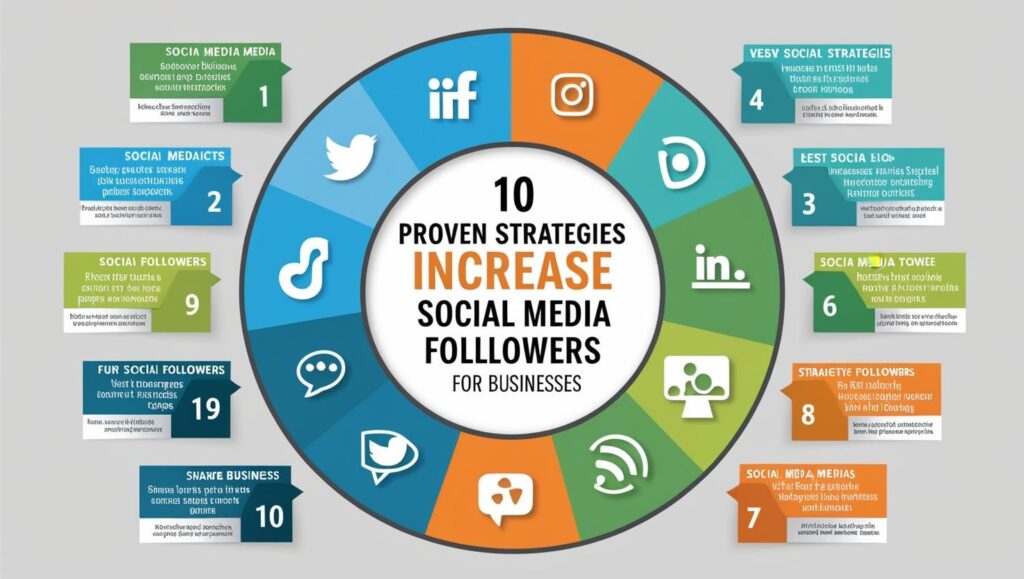
How to Increase Social Media Followers for Your Business Table of Contents Why Social Media Followers Matter for Business Identify Your Target Audience and Ideal Platforms Optimize Your Social Media Profiles for Visibility Create Valuable, Shareable Content Leverage Hashtags and Keywords Strategically Engage Consistently With Your Audience Collaborate With Influencers and Brands Run Contests, Giveaways & UGC Campaigns Boost Reach Through Paid Promotions Track Your Metrics and Improve Your Strategy Final Thoughts: Grow With Purpose How to Increase Social Media Followers for Your Business Social media followers aren’t just numbers—they’re potential customers, brand advocates, and revenue drivers. Whether you’re just starting out or looking to grow an existing audience, this guide breaks down 10 strategic steps to help you organically increase your social media followers for business success. 1. Why Social Media Followers Matter for Business Having more followers means broader reach, higher engagement, and ultimately, more leads and sales. In 2024, over 4.9 billion people used social media globally. Your audience is already there—it’s time to connect with them. An engaged follower base: Builds brand trust and authority Drives traffic to your website Helps spread your message organically Opens doors for influencer collaborations and partnerships 2. Identify Your Target Audience and Ideal Platforms Start with clarity: Who are you trying to attract? Create buyer personas that outline: Demographics (age, gender, location) Interests and behaviors Preferred platforms Example: If you’re a fitness brand targeting millennials, Instagram, TikTok, and YouTube may outperform LinkedIn. Use tools like: Meta Audience Insights Google Analytics Sprout Social demographics reports By focusing on the right platforms, your efforts become more targeted and effective. 3. Your Social Media Profiles for Visibility Your social media bio is your digital business card—optimize it for clarity and conversion. Tips: Use keywords relevant to your niche (e.g., “digital marketing for coaches”) Add a compelling call-to-action (CTA) with a clickable link Use a consistent brand profile image and cover Add contact info and highlight offers or services via pinned posts Bonus Tip: Use a link-in-bio tool like Link tree or Tap link to share multiple destinations. 4. Create Valuable, Shareable Content Content is the magnet that attracts followers. The more value you provide, the more likely users will follow and engage. Create a mix of: Educational posts (tips, how-to, industry news) Entertaining content (memes, behind-the-scenes) Inspirational quotes relevant to your niche User-generated content (reshare customer stories or photos) Use formats like: Reels and TikToks (great for discoverability) Infographics and carousels Stories and polls Lives and Q&As Stick to a content calendar to maintain consistency. Platforms reward regular posting. 5. Leverage Hashtags and Keywords Strategically Hashtags help new users discover your content. Keywords help you show up in search. How to use hashtags: Use a mix of trending, niche, and branded hashtags Avoid generic tags like #followme or #like4like Limit to 5–15 relevant tags per post (platform-dependent) SEO tip: Write captions and profile descriptions that naturally include target keywords like “increase social media followers for business.” Use tools like: Hashtagify.me KeywordTool.io (Instagram/Youtube/TikTok tabs) 6. Engage Consistently With Your Audience Want more followers? Engage like a human, not a bot. Reply to comments and DMs Like and comment on posts in your niche Use interactive features: polls, quizzes, and question boxes Tag and mention users, brands, and collaborators Platforms like Instagram and LinkedIn reward two-way interaction. Engagement helps your posts reach more people via algorithms. Pro Tip: Block 15–30 minutes daily for community interaction. 7. Collaborate With Influencers and Brands Partnering with influencers is a fast-track to gaining exposure and credibility. Options include: Sponsored posts or story shoutouts Co-branded giveaways IG Live or TikTok collaborations Brand ambassador programs Start with micro-influencers (1k–50k followers)—they often drive higher engagement and are more affordable. Don’t forget: Collaborations can also include other businesses in your niche. Cross-promote for mutual growth. 8. Run Contests, Giveaways & UGC Campaigns Contests are proven follower magnets when done right. Basic structure: Ask users to follow, like, and tag friends Offer a prize relevant to your audience Set a clear deadline and rules Announce and tag the winner publicly Encourage user-generated content (UGC): Photo or video challenges Testimonials or product-use stories “Tag us for a chance to be featured” UGC not only boosts reach but also builds trust with potential followers. 9. Boost Reach Through Paid Promotions Organic growth is great—but pairing it with smart paid campaigns can supercharge your results. Best performing ad types for follower growth: Boosted posts (high engagement content) Story ads with swipe-up CTAs Lookalike audience targeting (based on existing followers or website visitors) Influencer whitelisting (they run ads from their profile) Start with a small daily budget and test different creatives and calls to action. Key metrics to watch: cost-per-follower, reach, engagement rate, and click-through rate (CTR). 10. Track Your Metrics and Improve Your Strategy You can’t grow what you don’t measure. Track: Follower growth rate Engagement rate (likes + comments ÷ reach) Reach and impressions Top-performing content Referral traffic to your website Use tools like: Meta Business Suite Instagram Insights LinkedIn Analytics Google Analytics (for site traffic from social) Regularly review and refine your strategy based on performance. Double down on what works. Final Thoughts: Grow With Purpose Social media follower growth isn’t just about the numbers—it’s about building a community that aligns with your brand’s mission, values, and goals. Whether you’re using organic strategies, paid promotions, or influencer partnerships, stay consistent, provide value, and engage authentically. That’s the long-game formula for sustainable success on social media. 📥 Want help planning your social media content? Download our free 30-Day Social Media Calendar at DigitalMarketingKitz.com/templates to stay consistent and strategic! 🚀 Ready to Skyrocket Your Social Media Growth & Online Presence? At Digital Marketing Kitz, we don’t just talk about growth — we deliver it. Whether you’re a startup, personal brand, or established business, we offer powerful, done-for-you digital marketing services to help you dominate online. ✅ Social Media Marketing & Strategy✅ Facebook, Instagram & Google Ads✅ SEO & Keyword Research✅ Website Design & Optimization ✅ Email Marketing
Boosting Content Marketing: The Key to Brand Awareness
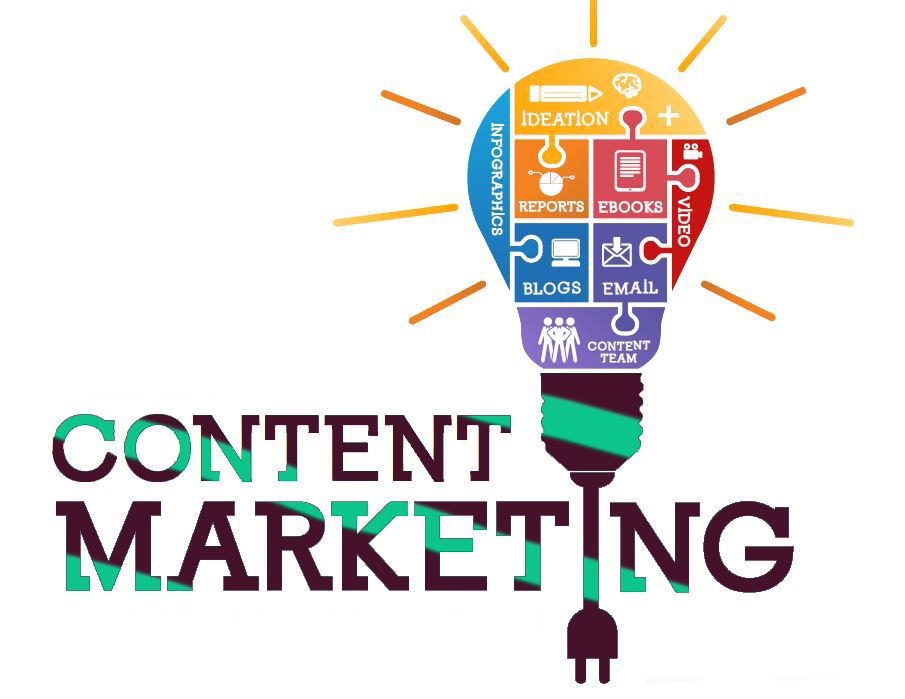
Content marketing is a strategic marketing approach focused on creating and distributing valuable, relevant, and consistent content to attract your audience. It is a form of marketing that focuses on creating, publishing, and distributing content for a targeted audience online. It is often used to achieve the following business goals: Attract attention and generate leads. Expand their customer base. Generate or increase online sales, increase brand awareness or credibility. Engage a community of online users. It starts with identifying the customer’s needs after that, the information can be presented in a variety of long form including News. Video. White papers. E-books,. Infographics. Email newsletters. Case studies. Podcasts. how-to guides, question and answer articles, photos, blogs, etc. Examples of short form content include short blog posts and social media posts. Content marketing requires continuous delivery of large amounts of content, preferably within a content marketing strategy It is a key to brand awareness, as it helps businesses: 1. Establish thought leadership: By creating high-quality, informative content, businesses can establish themselves as thought leaders in their industry. 2. Build trust and credibility: Consistent and valuable content helps build trust and credibility with the target audience. 3. Increase brand visibility: Content marketing helps businesses increase their online presence, making it easier for customers to find them. 4. Differentiate from competitors: Unique and high-quality content helps businesses differentiate themselves from competitors. 5. Drive website traffic and engagement: Content marketing can drive website traffic, increase engagement, and encourage sharing and advocacy. Types of Content Marketing 1. Blog posts: Articles published on a company’s website to educate and engage the target audience. 2. Videos: Explainer videos, product demos, or live streams to showcase a brand’s personality and expertise. 3. Social media posts: Short-form content shared on social media platforms to engage with the target audience. 4. E-books and guides: In-depth, downloadable resources that provide valuable information and insights. 5. Podcasts: Audio content that explores topics relevant to the target audience. 6. Webinars: Live or recorded online presentations to educate and engage the target audience. Benefits 1. Increased brand awareness: Content marketing helps businesses increase their online presence and visibility. 2. Lead generation: Valuable and relevant content can attract potential customers and encourage them to take action. 3. Cost-effective: Content marketing can be more cost-effective than traditional advertising methods. 4. Improved customer engagement: Content marketing helps businesses build relationships with their customers and encourage loyalty. 5. Measurable results: Content marketing efforts can be tracked and measured, providing valuable insights for future marketing strategies. Key to Successful Content Marketing 1. Know your audience: Understand your target audience’s needs, interests, and pain points. 2. Create high-quality content: Develop valuable, relevant, and consistent content that resonates with your target audience. 3. Distribute content effectively: Use various channels and platforms to distribute your content and reach your target audience. 4. Measure and analyze performance: Track and measure the performance of your content marketing efforts to refine your strategy. 5. Continuously improve and adapt: Stay up-to-date with industry trends and adjust your content marketing strategy accordingly. Types of Content Marketing for Brand Awareness 1. Blog Posts: Articles published on a company’s website to educate and engage the target audience. 2. Videos: Explainer videos, product demos, or live streams to showcase a brand’s personality and expertise. 3. Social Media Posts: Short-form content shared on social media platforms to engage with the target audience. 4. E-books and Guides: In-depth, downloadable resources that provide valuable information and insights. 5. Podcasts: Audio content that explores topics relevant to the target audience. 6. Webinars: Live or recorded online presentations to educate and engage the target audience. Brand awareness and visibility Businesses focused on expanding their reach to more customers will want to pay attention to the increase in the volume of visitors, as well as the quality of those interactions. Traditional measures of volume include the number of visitors to a page and number of emails collected Time spent on page and click-through to other pages/ photos are good indicators for engagement.[citation needed] Number of visitors to a page Time spent on the page Click-through across pages/ photos Number of emails collected Best Practices for Content Marketing 1. Know Your Audience: Understand your target audience’s needs, interests, and pain points. 2. Create High-Quality Content: Develop valuable, relevant, and consistent content that resonates with your target audience. 3. Distribute Content Effectively: Use various channels and platforms to distribute your content and reach your target audience. 4. Measure and Analyze Performance: Track and measure the performance of your content marketing efforts to refine your strategy. 5. Continuously Improve and Adapt: Stay up-to-date with industry trends and adjust your content marketing strategy accordingly.
